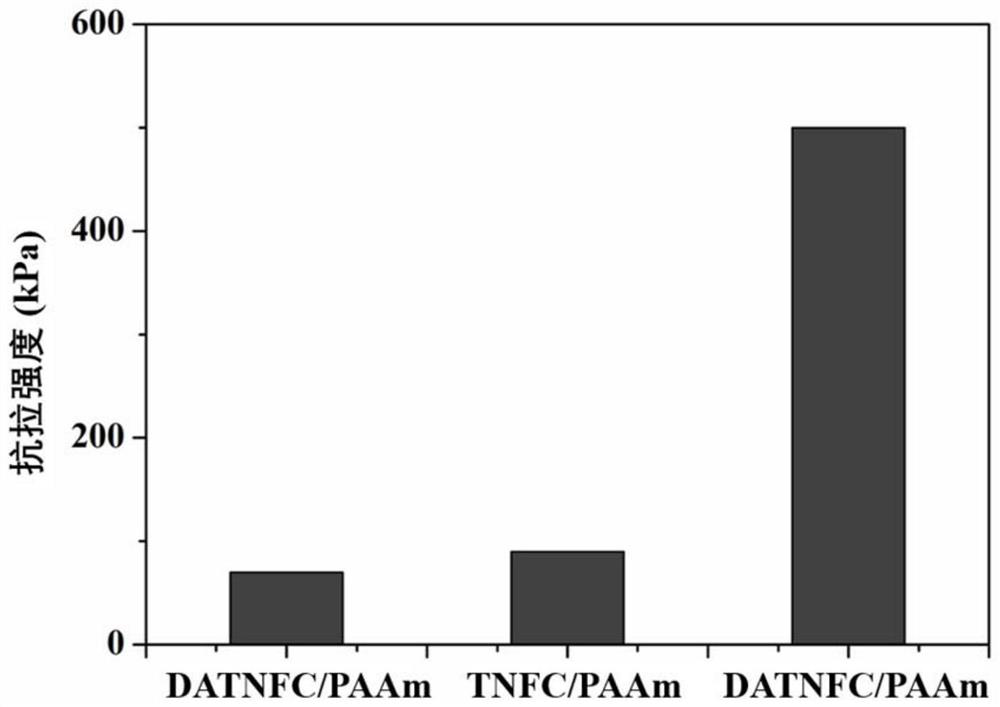Conductive hydrogel based on nanocellulose-polyacrylamide-metal ions as well as preparation method and application of conductive hydrogel
A polyacrylamide and nanocellulose technology, applied in the field of sensors, can solve the problems of imperfect influence of hydrogel performance, and achieve the effect of excellent self-healing performance, simple process and easy operation.
- Summary
- Abstract
- Description
- Claims
- Application Information
AI Technical Summary
Problems solved by technology
Method used
Image
Examples
Embodiment 1
[0041] A kind of preparation method of the conductive hydrogel based on nanocellulose-polyacrylamide-metal ion (flow process see figure 1 ), including the following steps:
[0042] (1) Preparation of nanocellulose suspension: Take 30g of bleached coniferous wood pulp and add it to 100g of water, use a Valli beater to process it for 6 minutes without hanging heavy objects, and then add 0.48g 2,2 to the cellulose suspension , 6,6-tetramethylpiperidin-1-oxyl group (TEMPO) and 3g NaBr, add sodium hypochlorite solution (the consumption of sodium hypochlorite is added by 13.5mmol / g cellulose, effective in sodium hypochlorite Chlorine content is 194.3g / L), by adding 1M NaOH, the pH value of the reaction is maintained at 10.0, after reacting for 1h, adding 50mL of absolute ethanol to terminate the reaction to obtain a cellulose suspension, and using a high-pressure homogenizer to homogenize under 90bar pressure for 10 TEMPO-nanocellulose (TNFC) containing carboxyl groups was obtained...
Embodiment 2
[0045] A method for preparing a conductive hydrogel based on nanocellulose-polyacrylamide-metal ions, comprising the following steps:
[0046] (1) Preparation of nanocellulose suspension: Take 30g of bleached coniferous wood pulp and add it to 100g of water, use a Valli beater to process it for 6 minutes without hanging heavy objects, and then add 0.48g 2,2 to the cellulose suspension , 6,6-tetramethylpiperidin-1-oxyl group (TEMPO) and 3g NaBr, add sodium hypochlorite solution (the consumption of sodium hypochlorite is added by 13.5mmol / g cellulose, effective in sodium hypochlorite Chlorine content is 194.3g / L), by adding 1M NaOH, the pH value of the reaction is maintained at 10.0, after reacting for 1h, adding 50mL of absolute ethanol to terminate the reaction to obtain a cellulose suspension, and using a high-pressure homogenizer to homogenize under 90bar pressure for 10 TEMPO-nanocellulose (TNFC) containing carboxyl groups was obtained after the second time; 15g of sodium p...
Embodiment 3
[0049] A method for preparing a conductive hydrogel based on nanocellulose-polyacrylamide-metal ions, comprising the following steps:
[0050] (1) Preparation of nanocellulose suspension: Take 30g of bleached coniferous wood pulp and add it to 100g of water, use a Valli beater to process it for 6 minutes without hanging heavy objects, and then add 0.48g 2,2 to the cellulose suspension , 6,6-tetramethylpiperidin-1-oxyl group (TEMPO) and 3g NaBr, add sodium hypochlorite solution (the consumption of sodium hypochlorite is added by 13.5mmol / g cellulose, effective in sodium hypochlorite Chlorine content is 194.3g / L), by adding 1M NaOH, the pH value of the reaction is maintained at 10.0, after reacting for 1h, adding 50mL of absolute ethanol to terminate the reaction to obtain a cellulose suspension, and using a high-pressure homogenizer to homogenize under 90bar pressure for 10 TEMPO-nanocellulose (TNFC) containing carboxyl groups was obtained after the second time; 15g of sodium p...
PUM
 Login to View More
Login to View More Abstract
Description
Claims
Application Information
 Login to View More
Login to View More - R&D
- Intellectual Property
- Life Sciences
- Materials
- Tech Scout
- Unparalleled Data Quality
- Higher Quality Content
- 60% Fewer Hallucinations
Browse by: Latest US Patents, China's latest patents, Technical Efficacy Thesaurus, Application Domain, Technology Topic, Popular Technical Reports.
© 2025 PatSnap. All rights reserved.Legal|Privacy policy|Modern Slavery Act Transparency Statement|Sitemap|About US| Contact US: help@patsnap.com


